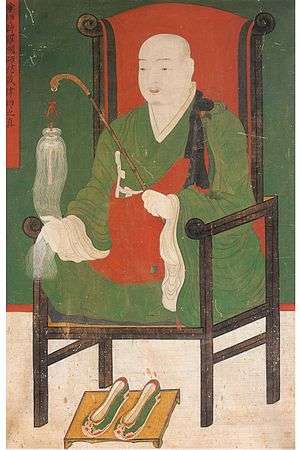Jajang
Jajang (590–658) was a monk born Kim Seonjong, into the royal Kim family, in the kingdom of Silla. He is credited with founding the temple of Tongdosa in 646 CE, near in what is now Busan, South Korea, and played a significant role in the adoption of Buddhism as the national religion of Silla. His biography is told in the anthology of Korean Buddhism: "Jogye Culture Web", Vol 10.[1]
| Jajang | |
 Painting of Jajang (artist unknown). | |
| Korean name | |
|---|---|
| Hangul | 자장 율사 |
| Hanja | |
| Revised Romanization | Jajang Yulsa |
| McCune–Reischauer | Chajang Yulsa |
| Birth name | |
| Hangul | 김선종 |
| Hanja | |
| Revised Romanization | Kim Seonjong |
| McCune–Reischauer | Kim Sŏnchong |
Training
In 636 Jajang traveled to China to study under the great Buddhist masters of the Tang Dynasty China,[2] for seven years[3] becoming a taeguksa (Great Noble Priest) upon returning, receiving the highest honors from Queen Seondeok.
Treasures
When Jajang returned from China he was given invaluable holy treasures: a fragment of the original Sakyamuni Buddha's skull, a wooden begging-bowl and monastic-robe of Buddha, and 100 of the Buddha's "sarira" (pearl or crystal-like bead-shaped objects that are purportedly found among the cremated ashes of Buddhist spiritual masters).
Reputation
Because of his sharp mind he was repeatedly requested by the King to take a position of responsibility at court. Jajang repeatedly refused these requests so finally the King issued an ultimatum: "If you do not accept this official position I offer, I will have your head severed for disobedience." Jajang replied "I would rather die keeping the commandments of Buddha for one day than live for a hundred years while breaking them." The King seeing the wisdom in Jajang's reply relented allowing Jajang to remain a monk.[4]
Temples
Jajang established many temples but Tongdosa, one of the Three Jewel Temples of Korea, is considered the most important.
Temples of note:
- Magoksa in 640 or 642
- Bongjeongam (Phoenix Bower Hermitage) in 642[5]
- Sangwonsa in 643[6]
- Oseam in 643
- Woljeongsa in 643
- Tongdosa in 646.
- Sinheungsa in 652[7]
- Manggyeongsa Temple in Taebaek on the Taebaek Mountains[8]
References
- Jogye Order; Culture Web Vol. 10, pp. 180/1
- "Koreatimes". Retrieved 12 December 2010.
- "Britannica.com". Retrieved 14 December 2010.
- Adams, Edward (1983). Korea Guide - A Glimpse of Korea's Cultural Legacy. Seoul, South Korea: Seoul International Tourist Publishing Company. p. 208.
- "Lifeinkorea". Retrieved 14 December 2010.
- "Pleasetakemeto". Archived from the original on 14 July 2010. Retrieved 14 December 2010.
- "Discoverkorea". Archived from the original on 14 April 2011. Retrieved 14 December 2010.
- Cin Woo Lee "Simply stunning: 33 incredible Korean temples" Archived 14 April 2012 at the Wayback Machine CNN Go. 10 February 2012. Retrieved 2012-04-12